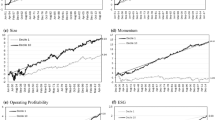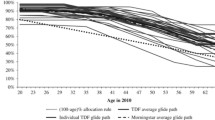Abstract
This article aims to determine whether style-neutral portfolios built out of value and growth equity/mutual funds deliver benefits in terms of returns and diversification or whether they result in costly benchmark tracking products. We analyze style-neutral portfolios by building synthetic funds of funds (FoFs) out of both value- and growth-oriented equity funds and contrast their properties with the applicable benchmark and with style FoFs. Although a beneficial effect with respect to diversification and a resulting reduction in return dispersion can be seen, the simulated FoFs do not deliver a general risk-adjusted outperformance against the benchmark or the better performing style of a period. The variety of results indicates that FoFs may indeed benefit from investing in a style-neutral portfolio of growth and value funds, but only given that FoF managers are able to select the well-performing funds of the respective styles. In addition, we find that being able to shift between styles over time may lead to better results than locking FoFs into being style neutral.





Similar content being viewed by others
Notes
Another popular extension is provided by the four-factor model of Carhart (1997), who augmented the analysis with a momentum factor. See Haugen and Baker (1996) for a discussion of 50 possible influencing factors.
See Brown et al (2004) for a discussion of fees on fees in FoFs.
Connelly acknowledges that this measure is obtained from a presentation by William Jacques at a conference on active versus passive investment management sponsored by the Institute for International Research.
See Chan et al (2005) for an examination of managers’ foreign and domestic biases.
According to information from Morningstar, three value and 13 growth funds were obsolete from the data set chosen. However, the focus of this study is the effect of style-neutrality, such that the survivorship influence is not crucial.
While some funds report prices at the end of the day, others report prices for the day before. The latter method, called forward-pricing, aims at preventing speculative trading against the fund.
Other possibilities include setting the upper and lower percentage to equal values in order to obtain a symmetric reward-to-risk measure rather than one that controls for large underperformances that serve as risk measures in the denominator.
References
Ahmed, P., Lockwood, L. and Nanda, S. (2002) Multistyle rotation strategies. Journal of Portfolio Management 28: 17–29.
Amenc, N., Malaise, P., Martellini, L. and Sfeir, D. (2003) Tactical style allocation – A new form of market neutral strategy. Journal of Alternative Investments 6: 8–23.
Biglova, A., Ortobelli, S., Rachev, S.T. and Stoyanov, S. (2004) Different approaches to risk estimation in portfolio theory. Journal of Portfolio Management 31: 103–112.
Brands, S. and Gallagher, D.R. (2005) Portfolio selection, diversification and fund-of-funds: A note. Accounting & Finance 45: 185–197.
Brown, S.J., Goetzmann, W.N. and Liang, B. (2004) Fees on fees in funds of funds. Journal of Investment Management 2: 39–56.
Carhart, M.M. (1997) On persistence in mutual fund performance. Journal of Finance 52: 57–82.
Chan, K., Covrig, V. and Ng, L. (2005) What determines the domestic bias and foreign bias? Evidence from mutual fund equity allocations worldwide. Journal of Finance 60: 1495–1534.
Connelly, T.J. (1997) Multi-fund diversification issues. Journal of Financial Planning 10: 34–37.
DiBartolomeo, D. (1999) A Radical Proposal for the Operation of Multi-Manager Investment Funds. working paper. Northfield Information Services.
Fama, E.F. and French, K.R. (1992) The cross-section of expected stock returns. Journal of Finance 47: 427–465.
Fama, E.F. and French, K.R. (1993) Common risk factors in the returns on stocks and bonds. Journal of Financial Economics 33: 3–56.
Fama, E.F. and French, K.R. (1998) Value versus growth: The international evidence. Journal of Finance 53: 1975–2000.
Fan, S. (1995) Equity style timing and allocation. In: R. Klein and J. Lederman (eds.) Equity Style Management. Chicago, IL: Irwin.
Farinelli, S., Ferreira, M., Rossello, D., Thoeny, M. and Tibiletti, L. (2009) Optimal asset allocation aid system: From one-size versus tailor-made performance ratio. European Journal of Operational Research 192: 209–215.
Gallagher, D.R. and Gardner, P. (2006) The implications of blending specialist active equity fund management. Journal of Asset Management 7: 31–48.
Gerber, G. (1994) Equity style allocations: Timing between growth and value. In: J. Jederman and R. Klein (eds.) Global Asset Allocation: Techniques for Optimizing Portfolio Management. New York: Wiley.
Graham, B. and Dodd, D. (1934) Security Analysis. New York and London: McGraw-Hill.
Graham, B. and Dodd, D. (1949) The Intelligent Investor. New York and London: Collins.
Haugen, R. and Baker, N. (1996) Commonality in the determinants of expected stock returns. Journal of Financial Economics 41: 401–439.
Lhabitant, F. and Learned, M. (2003) Hedge fund diversification: How much is enough? Journal of Alternative Investments 5: 49.
Okuyama, N. and Francis, G. (2007) Quantifying the information content of investment decisions in a multiple partial moment framework: Formal definition and applications of generalized conditional risk attribution. Journal of Behavioral Finance 3: 121–137.
O'Neal, E.S. (1997) How many mutual funds constitute a diversified mutual fund portfolio? Financial Analysts Journal 53 (2): 37–46.
Park, J. and Staum, J. (1998) Fund of funds diversification: How much is enough? Journal of Alternative Investments 1: 39–42.
Rachev, S., Menn, C. and Fabozzi, F. (2005) Fat-Tailed and Skewed Asset Return Distributions: Implications for Risk Management, Portfolio Selection, and Option Pricing. Hoboken, NJ: Wiley.
Rachev, S., Ortobelli, S., Stoyanov, S., Fabozzi, F. and Biglova, A. (2008) Desirable properties of an ideal risk measure in portfolio theory. International Journal of Theoretical & Applied Finance 11: 19–54.
Sorensen, E. and Lazzara, C. (1995) Equity style management: The case of growth and value. In: R. Klein and J. Lederman (eds.) Equity Style Management. Chicago, IL: Irwin.
Acknowledgements
The authors thank Frank J. Fabozzi for helpful comments. We bear responsibility for any remaining errors. The views expressed herein are those of the authors, and do not necessarily represent those of Credit Suisse.
Author information
Authors and Affiliations
Corresponding author
Appendix
Appendix
Figure A1, Figure A2, Figure A3 and Figure A4, Table A1, Table A2 and Table A3
(a) Difference in lowest annualized geometric mean return for style-neutral FoFs against the benchmark. (b) Difference in lowest annualized geometric mean return for value sub FoFs against the benchmark. (c) Difference in lowest annualized geometric mean return for growth sub FoFs against the benchmark. (d) Difference in highest annualized geometric mean return for style-neutral FoFs against the benchmark. (e) Difference in highest annualized geometric mean return for value sub FoFs against the benchmark. (f) Difference in highest annualized geometric mean return for growth sub FoFs against the benchmark.
(a) Difference in lowest annualized standard deviation for style-neutral FoFs against the benchmark. (b) Difference in lowest annualized standard deviation for value sub FoFs against the benchmark. (c) Difference in lowest annualized standard deviation for growth sub FoFs against the benchmark. (d) Difference in highest annualized standard deviation for style-neutral FoFs against the benchmark. (e) Difference in highest annualized standard deviation for value sub FoFs against the benchmark. (f) Difference in highest annualized standard deviation for growth sub FoFs against the benchmark.
(a) Difference in lowest skewness for style-neutral FoFs against the benchmark. (b) Difference in lowest skewness for value sub FoFs against the benchmark. (c) Difference in lowest skewness for growth sub FoFs against the benchmark. (d) Difference in highest skewness for style-neutral FoFs against the benchmark. (e) Difference in highest skewness for value sub FoFs against the benchmark. (f) Difference in highest skewness for growth sub FoFs against the benchmark.
(a) Difference in lowest kurtosis for style-neutral FoFs against the benchmark. (b) Difference in lowest kurtosis for value sub FoFs against the benchmark. (c) Difference in lowest kurtosis for growth sub FoFs against the benchmark. (d) Difference in highest kurtosis for style-neutral FoFs against the benchmark funds. (e) Difference in highest kurtosis for value sub FoFs against the benchmark. (f) Difference in highest kurtosis for growth sub FoFs against the benchmark.
Rights and permissions
About this article
Cite this article
Stein, M., Rachev, S. Style-neutral funds of funds: Diversification or deadweight?. J Asset Manag 11, 417–434 (2011). https://doi.org/10.1057/jam.2010.5
Received:
Revised:
Published:
Issue Date:
DOI: https://doi.org/10.1057/jam.2010.5








